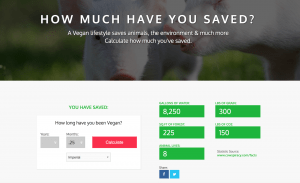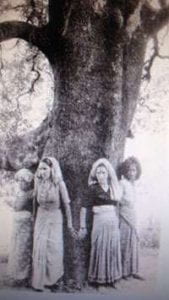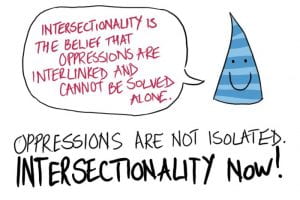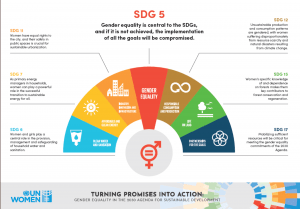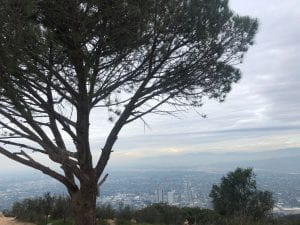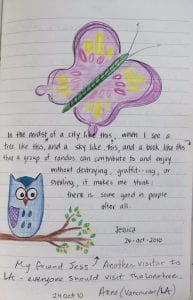Most people are familiar with the concept that advertisements are sexualized. “Sex sells!” is what they say, right? As a society, we’ve become almost immune to seeing women in sexy poses or little clothing, often to sell clothing itself or often something completely unrelated. For example, look at this American Apparel ad that is supposed to be selling a turtleneck sweater.

This ad is not selling a sweater. It is selling an idea, a concept. It is selling sexuality. It is objectifying the woman in the ad in order to appeal to a hungry consumer. It is participating in a patriarchal society that wants to take away who the actual person is, but show what their body looks like in an alluring way.
The same concept applies to animals in advertising. Carol Adams, author of the book The Pornography of Meat, says that “Women are animalized and animals are sexualized and feminized.” She coined the term “anthropornography,” which means is when animals are shown as sexually consumable, in the same way that sexually exploits women. I never realized how common this was until reading Adams’ words. Let’s look at some examples.

This ad shows a pig’s head on a woman’s body. The body is wearing a bikini. She is covered in tattoos, which are traditionally viewed as risqué or promiscuous. She is lounging back in an alluring way. When translated to English, “fajna” means cool and “swinka” seems to mean pig. So what we’re looking at in this advertisement is a cool pig. I am not sure if this is for a specific brand, or if it’s literally just advertising the consumption of pork. Either way, it completely is taking away who the pig actually is. The fragmentation of both the pig and the woman shows complete disregard for who each actual is as a living creature. We aren’t supposed to think of them as living creatures. This ad is meant to entice men to eat meat. Eating meat is already viewed as a primarily masculine thing to do. This ad makes it look like this pig/woman WANTS to be eaten.
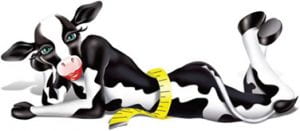
This ad is for the brand Skinny Cow, which is a diet ice cream brand marketed towards women. It features a cow with overtly feminine features, like it’s wearing makeup. The cow’s body is skewed and wrapped up in measuring tape to measure it’s waist. This whole campaign is sexist for so many reasons. First, the idea of normal ice cream being bad and this ice cream being better because it’s skinny is insulting to women. Women are supposed to feel guilty for eating full-fat items, so this product is telling them they can finally eat ice cream and have a nice body/lose weight. A cow does not have defined hips and a skinny waist. This logo totally morphs a cow’s body. A cow is also a term commonly used to shame a person for their weight. The morphing of the cow into something skinnier, thus better, is insulting for both animals and women. The cartoon aspect of the drawing takes away from the reality that this ice cream comes from a cow, who certainly did not consent to providing milk for a mass-produced frozen diet treat. The cartoon makes it seem lighthearted, fun, sexy, and cool. This is sending a message to women that if you eat this food, you will be those things too!

This third ad would maybe be considered more of a meme. It’s a “quirky” picture that was shared on Facebook. I read this and immediately thought, “ew.” This is obviously targeted towards men and the idea of masculinity laying in both eating meat and also being good in bed. It is suggesting that both animals and women are objects for consumption. It is going with the sexual violence theme of women “asking for it.” Even past misogyny, it plays up racism and privilege, as it shows a white pilgrim being so excited for his dinner. We’re just going to overlook the American history of genocide that white pilgrims caused? It also demonstrates Adam’s hierarchy, posted below.
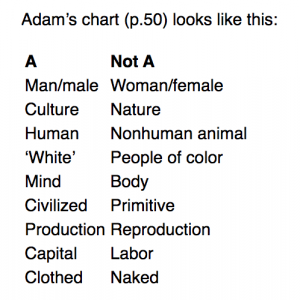
In the chart, column A is the side that has privilege over column “not A.” You’ll notice that everything in the second column is what we typically see being used in advertisements for consumption.
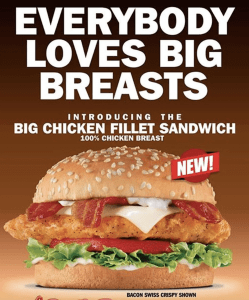
This last ad is an in your face sexualized ad from Carl’s Jr. You look at it, and “BIG BREASTS” catches your eye. This ad is not shy in what it is trying to do. It’s saying, “hey you’re manly, you love boobs…you’ll love this chicken sandwich!” This is another example of fragmentation. By simplifying women down to a pair of boobs, and chicken down to just their breast meat, it makes it easier for a person to consume. At that point, they are not living, breathing creatures. They’re just parts. This ad is trying to be sassy and lighthearted, but it’s actually contributing to the normalization of exploitation of women/animals.
I just showed four examples. There are countless others. Now that you’ve seen it exemplified, you’ll see ads like this in your daily life. Women are not objects, just as animals are not. The way that advertisements make living creatures two-dimensional in order to sell a product is problematic, but our culture has become so immune to it. Just being able to recognize it is a step in the right direction.
Works Cited:
Adams, Carol. The Pornography of Meat, NY: Continuum, 2003.
Kemmerer, Lisa. “The Pornography of Meat by Carol Adams.” Philosophy Now: a Magazine of Ideas, 2006, philosophynow.org/issues/56/The_Pornography_of_Meat_by_Carol_Adams.
Williams, Laura Anh. “Gender, Race, and an Epistemology of the Abattoir in My Year of Meats.” Feminist Studies, vol. 40, no. 2, 2014, pp. 244–272. JSTOR, www.jstor.org/stable/10.15767/feministstudies.40.2.244. Accessed 1 Mar. 2020.
Laura Anh Williams is an assistant professor and director of the women’s studies program at New Mexico State University. This source is well-researched and cites its own sources throughout.

